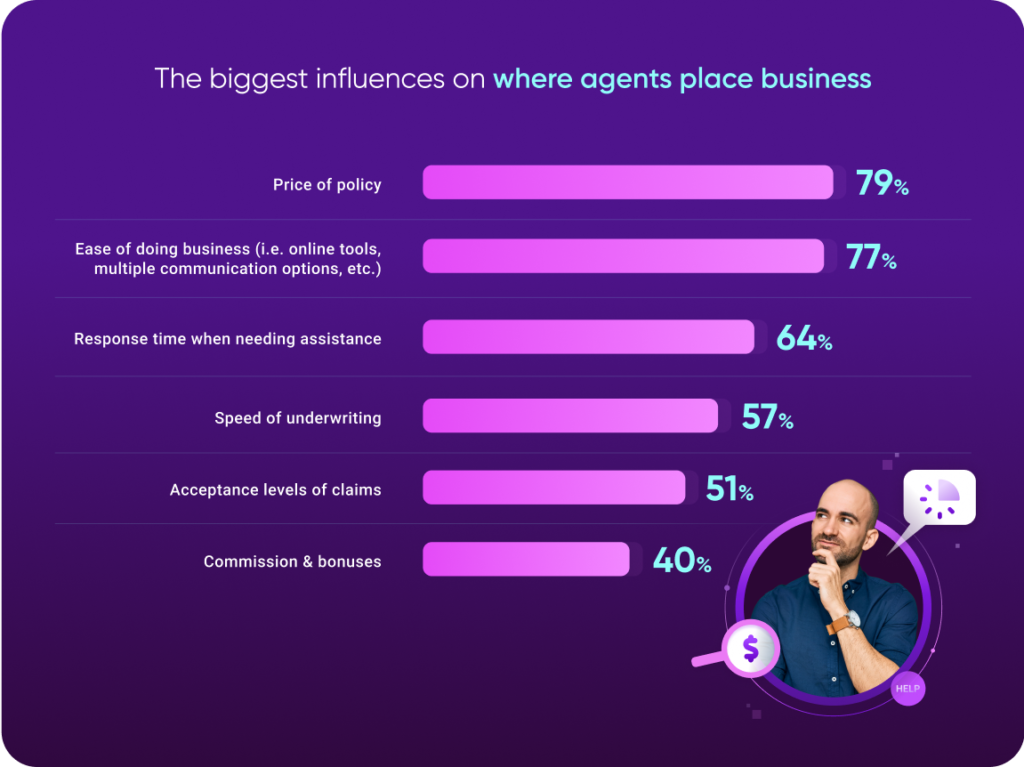Just as the customer experience is critical to retention rates and business growth, so too is the agent experience for insurance carriers who distribute policies through agents and brokers.
We completed research with more than 500 independent insurance agents to better understand how their experience working with carriers compares to their expectations and preferences. We then partnered with Digital Insurance and Ryan Hanley, chairman of ITC Agents and founder of Finding Peak, to discuss the top trends shaping the agent-carrier relationship.
Below are three of the key trends that were discussed during the webinar. You can view the full recording here.
Lack of Real-Time Support in Carrier Portals
In our research, we found that 79% of insurance agents report being always or almost always on a carrier’s portal when they need assistance from that carrier.
Despite this trend, interaction channels haven’t kept pace with business now being predominantly conducted online. When we asked insurance agents what support channels they use today, phone (86%) and email (85%) were the top two by a significant margin.
Both of these channels are disconnected from the online portal experience, requiring agents to either navigate to email and wait for a delayed response, or place a call that often goes unanswered. When that call is answered by a carrier representative, the rep has no context for where that agent is in the portal, creating friction in their ability to provide timely and effective assistance.
When we asked agents what channels they’d like to use, they expressed more desire for real-time support directly from the carrier’s portal. Hanley, a former producer and agency owner, shared in the webinar how few carriers he’s worked with offer live assistance and how frustrating of an experience it can be for agents.
There are very few, if any carriers, that have a real-time experience associated with their portal.
– Ryan Hanley, chairman of ITC Agents and founder of Finding Peak
“So what happens is you have this frustrating moment, you have to back out of the process, maybe you try again, if it happens again now you have to email or call somebody. You’re never going to get a hold of somebody in that moment, and now this thing that should have just taken place, is now taking up 3, 4, 5 times as much as it should. Frustration ensues and what ends up happening is ultimately we start heading towards the paths of least resistance.”
Ease of Doing Business Key to Becoming Agents’ Preferred Carrier
As Hanley noted, a frustrating experience working in a carrier’s system can lead agents to place more business with carriers that provide a more streamlined experience. The results from the survey further back up this trend.
When asked for the most influential factors in where they decide to place business, agents ranked ease of doing business (77%) nearly on par with price (79%) as a determining factor in which carrier they prefer.

“If you’re competing on price, you’re in a race to the bottom. But if you’re competing on experience, you’re on a journey to the top,” said Rick DeLisi, Lead Research Analyst at Glia. ”Price can be the last thing that matters when prices are essentially equal and that allows the opportunity to compete on ease of doing business, effortlessness—the overall agent experience.”
If you’re competing on price, you’re in a race to the bottom. But if you’re competing on experience, you’re on a journey to the top.
– Rick DeLisi, Lead Research Analyst at Glia
Hanley summarized the impact that having a frustrating portal experience and no real-time support option can have on agents.
“The less time you can spend in the portal, the less time you can spend actually processing that transaction—in this case getting a proposal or binding an account—that’s where they’re going to go,” Hanley said.
“Your production force wants to get back on the phone with another prospect so they can put more business on the books. And every minute wasted inside a portal or every frustration associated with a portal is the next time they’re not going to come back. And then all of a sudden you just get carved out. And I think it happens way, way more times than carriers understand.”
Agent-Carrier Relationships Are Built Online
As evidenced by the amount of time agents say they spend in carrier portals, there’s no doubt that agents are online now more than ever. While carriers used to build and develop relationships with their network of agents in person, these relationships are now largely forged digitally.
But just because agents are in the same room as carriers, doesn’t mean the personal touch and relationship building is completely going away. The digital tools available now, from software providers like Glia, can help carriers build stronger relationships with their agent base online.
Features like live chat, video, or CoBrowsing, which allows carrier reps and agents to leverage dual-cursor navigation on the page the agent is on within the carrier’s system, can reduce the impersonal nature of email. Implementing digital customer service channels within an agent portal can provide a carrier’s team with the tools needed for a more personalized experience that differentiates them from other carriers.
“As tools like CoBrowing become more accessible…those are really good use cases to build that quasi face-to-face interaction with your user base that you used to get when you shared air,” Hanley said. “Now you can have that similar interaction, that similar relationship building through the computer, and I think CoBrowsing is one of the tools that can do that.”
Want to hear more from Ryan Hanley and Rick DeLisi on the trends shaping the agent-carrier relationship? Check out the full webinar recording here.





